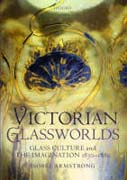
Victorian Glassworlds: glass culture and the imagination 1830-1880
Armstrong, Isobel
Isobel Armstrong's book tells the stories that spring from the mass-production of glass in 19th-century England. Moving across technology, industry, local history, architecture, literature, print culture, the visual arts, optics, andphilosophy, it will transform our understanding of the Victorian period. INDICE: Introduction. The Poetics of Transparency -- Part I. Facets of glass culture: making and breaking glass -- 1. Factory Tourism: Morphology of the'Visit to a Glass Factory' -- 2. Robert Lucas Chance, Modern Glass Manufacturer: Fractures in the Glass Factory -- 3. Riot and the Grammar of Window-Breaking: The Chances, Wellington, Chartism -- 4. The Glassmakers' Eloquence: A Trade Union Journal, the Royal Commission, 1868 -- Part II. Perspectives of the glass panel: windows, mirrors, walls -- 5. Reflections, Translucency, Aura, and Trace -- 6. Glassing London: Building Glass Culture, Real and Imagined -- 7. Politics of the Conservatory: Glasshouses, Republican and Populist -- 8. Mythmaking: Cinderella and her Glass Slipper at the Crystal Palace -- 9. Glass underGlass: Glassworld Fictions -- Part III. Lens-made images: optical toys and philosophical instruments -- 10. The Lens, Light, and the Virtual World -- 11. Dissolving and Resolving Views: From Magic Lantern to Telescope -- 12. Microscopic Space -- 13. Crystalphiles, Anamorphobics, and Stereoscopic Volume -- 14. Coda on Time: Fixing the Moving Image and Mobilizing the Fixed Image-Memory, Repetition, and Working Through -- Conclusion: The End of Glass Culture-from Nineteenth-Century Modernity to Modernism.
- ISBN: 978-0-19-920520-2
- Editorial: Oxford University
- Encuadernacion: Cartoné
- Páginas: 472
- Fecha Publicación: 01/04/2008
- Nº Volúmenes: 1
- Idioma: Inglés
